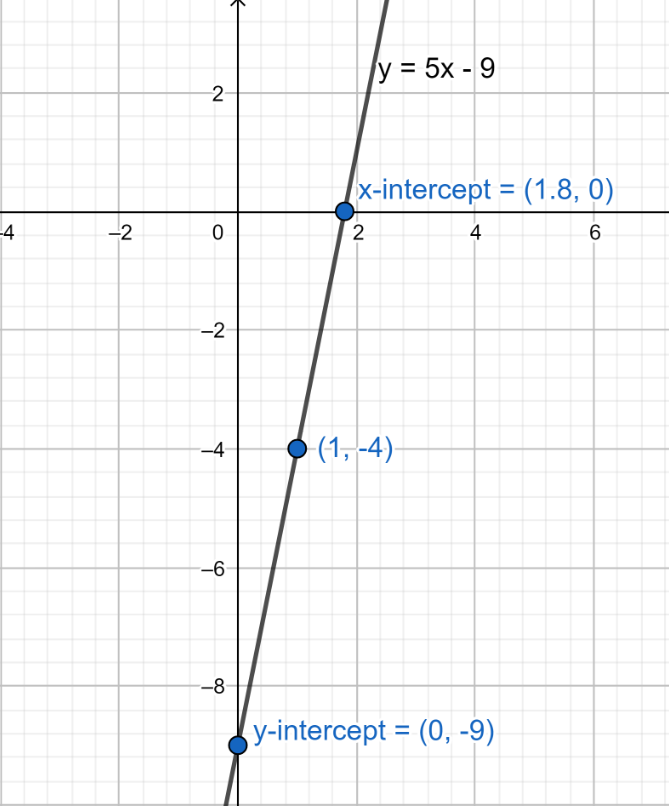
How do you find the slope and intercept to graph
Answer
466.8k+ views
Hint: In this given problem, we have a line equation, in which we have to find the slope and intercepts, to plot the graph. We know that slope intercept form is
Complete step by step answer:
We know that the given slope intercept form is,
We also know that the general form of the slope intercept form is,
Where, m is the slope and c, y-intercept.
Now we can compare equation (1) and (2), we get
Slope, m = 5 and y-intercept, c = -9
We also know that at y-intercept, x = 0.
Therefore, the point at y-intercept is
Now, we have to find the x-intercept.
We know that at x-intercept, y = 0. Substituting the value of y in equation (1), we get
Therefore, the point at x-intercept is
We can also find some other points to be plotted in the graph where the line passes through.
We can assume for x = 1, then from (1).
Therefore, the other point is
Now we can plot the graph using x-intercept

Note:
Students make mistakes in finding the value of x-intercept and y-intercept, we should know that at x-intercept the value of y is 0 and at y-intercept the value of x is 0. We should also concentrate on formulae like slope intercept formulas, to solve these types of problems.
Complete step by step answer:
We know that the given slope intercept form is,
We also know that the general form of the slope intercept form is,
Where, m is the slope and c, y-intercept.
Now we can compare equation (1) and (2), we get
Slope, m = 5 and y-intercept, c = -9
We also know that at y-intercept, x = 0.
Therefore, the point at y-intercept is
Now, we have to find the x-intercept.
We know that at x-intercept, y = 0. Substituting the value of y in equation (1), we get
Therefore, the point at x-intercept is
We can also find some other points to be plotted in the graph where the line passes through.
We can assume for x = 1, then from (1).
Therefore, the other point is
Now we can plot the graph using x-intercept

Note:
Students make mistakes in finding the value of x-intercept and y-intercept, we should know that at x-intercept the value of y is 0 and at y-intercept the value of x is 0. We should also concentrate on formulae like slope intercept formulas, to solve these types of problems.
Recently Updated Pages
Master Class 11 Economics: Engaging Questions & Answers for Success

Master Class 11 Business Studies: Engaging Questions & Answers for Success

Master Class 11 Accountancy: Engaging Questions & Answers for Success

Master Class 11 English: Engaging Questions & Answers for Success

Master Class 11 Computer Science: Engaging Questions & Answers for Success

Master Class 11 Maths: Engaging Questions & Answers for Success

Trending doubts
State and prove Bernoullis theorem class 11 physics CBSE

What are Quantum numbers Explain the quantum number class 11 chemistry CBSE

Write the differences between monocot plants and dicot class 11 biology CBSE

Why is steel more elastic than rubber class 11 physics CBSE

Explain why a There is no atmosphere on the moon b class 11 physics CBSE

1 ton equals to A 100 kg B 1000 kg C 10 kg D 10000 class 11 physics CBSE




